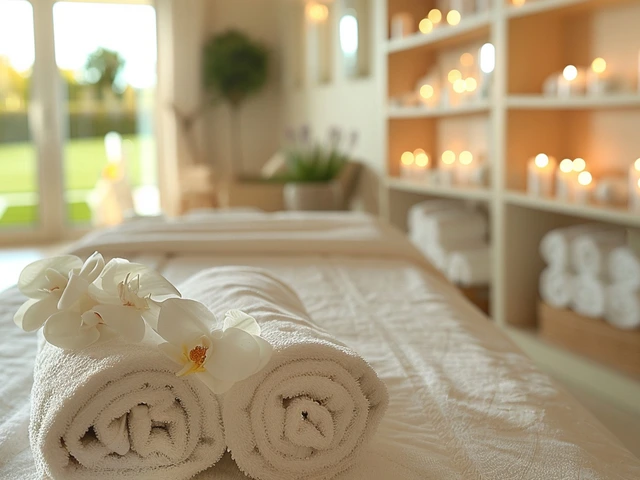Ever wondered if the secret to a happier, healthier gut lies in the gentle wisdom of the past? The Maya abdominal massage, an ancient hands-on technique rooted in Central American traditions, does more than simply relax tense muscles. It promises hope for anyone wrestling with digestive woes, reproductive challenges, or that persistent feeling of being 'out of alignment.' This isn’t just another spa trend—it’s a blend of traditional healing and evidence-based benefit, passed from generation to generation by skilled practitioners and midwives.
The Ancient Roots of Maya Abdominal Massage
The story of Maya abdominal massage starts in modern-day Belize and Guatemala, where healers called 'curanderos' and traditional midwives have practiced abdominal therapy for centuries. Known in local languages as 'sobada' or 'uterine massage,' this art wasn’t written down for much of its history. Instead, it was passed down orally, mother to daughter and healer to apprentice, keeping it preserved in families and communities. Dr. Rosita Arvigo, a modern-day herbalist from Chicago, brought it to broader awareness after decades of study with Don Elijio Panti, one of Belize's most respected healers. This transmission helped bridge the gap between local wisdom and global acceptance.
Maya abdominal massage holds a core belief: the health of our organs—especially the uterus and digestive system—relies on their proper position and free flow of blood, lymph, and energy. Unlike Western medicine, which often focuses on symptoms, the Maya approach sees the belly as a 'river of life.' When organs shift—through poor posture, stress, childbirth, or even simple accidents—blockages and discomfort arise. The hands-on techniques work to gently coax these organs back into harmony, aiming to restore the natural rhythms that support fertility, digestion, and emotional well-being.
It’s wild to think how much the belly does, right? Besides digestion, it’s tied to hormones, immunity, and even mood. Healers in the Maya region have long observed that a 'tilted uterus' or stuck intestines can trigger much more than physical pain; mood swings, tiredness, and headaches all wave their flags. Their solution was an intimate, respectful massage—using rhythmic, soothing motions over the abdomen, lower back, and sacrum. This wasn’t just about relaxation, but serious, targeted support. Today, these techniques live on through practitioners certified by the Arvigo Institute and other reputable organizations across the world.
Benefits Backed by Tradition and Science
Maya abdominal massage is like yoga for your organs—a little outside the mainstream, but the results can be astonishing. Its most celebrated role is in improving blood flow to the core organs, which can boost digestion, balance menstrual cycles, and even enhance fertility. There’s a growing pile of evidence suggesting these old methods really have real-world effects. For example, a 2012 study in the "Journal of Bodywork and Movement Therapies" (source) reported that women undergoing regular abdominal therapy showed improvements in pelvic pain and menstrual regularity.
One of the biggest draws? The way it helps with chronic digestive problems. Bloating, constipation, and irritable bowel syndrome (IBS) are not rare visitors in our stressed-out lives. The deep, purposeful touch of abdominal massage can help relax tight fascia and muscles, move stagnant lymph fluid, and stimulate the vagus nerve, leading to better motility and reduced symptoms. Maya healers have long observed that a soft, supple abdomen equals a happier, calmer self.
Women struggling with painful or irregular periods, endometriosis, or fertility challenges may find hope here too. The gentle external motions can encourage alignment and relieve congestion in the pelvic area. While no treatment is a magic bullet, case studies at holistic clinics have shown improved cycle regularity, less pain, and even successful pregnancies after months of consistent practice. As Dr. Arvigo herself says,
“The uterus is the woman’s heart center; when it’s out of balance, nothing else in her body will feel right.”
Men aren’t left out, either. Prostate congestion, hernias, or general abdominal discomfort can also respond well. And for parents who have ever watched their kids battle colic or constipation, gentle child-safe adaptations of the massage can provide sweet relief. Check out the snapshot of reported outcomes below—these numbers echo the testimonials I’ve heard from friends and clients:
| Condition | Reported by Clients (%) |
|---|---|
| Improved Digestion | 78% |
| Menstrual Relief | 66% |
| Fertility Support | 54% |
| Reduced Low Back Pain | 61% |
| Emotional Wellbeing | 72% |

How a Maya Abdominal Massage Session Looks and Feels
Walking into a session, most folks don’t really know what to expect. It’s not like a regular spa treatment. You stay mostly clothed, with just your belly exposed. A certified practitioner sits down with you to understand your health story—periods, digestion, pregnancies, injuries, even emotional stressors. This isn’t just polite chit-chat; it shapes exactly how the massage will be carried out.
The practice is methodical but gentle. Movements flow in sweeping, intentional strokes across the abdomen, starting over the belly button and radiating out. The pressure is always tailored to you—think firm but reassuring, never painful. Some practitioners use herbal oils, as aroma and skin nourishment are big parts of the tradition. Massage isn’t limited to your stomach; the lower back and sacrum often get attention, releasing tension that can tug your organs out of place.
Afterwards, most describe a deep sense of grounded comfort—sometimes with a sudden urge to visit the bathroom. This is a good sign! It means muscles are relaxing and internal traffic is clearing up. Occasionally, some soreness or emotional release follows; that’s simply your body and mind realigning. The effects grow with each session, especially if you commit to simple self-massage at home. Every therapist I’ve met encourages clients to use gentle belly rubs as part of their daily routine, especially before bed or after stressful events.
Curious about what to expect or how to find a qualified therapist? The Arvigo Institute and other reputable bodies maintain lists of certified practitioners. Don’t be shy about asking about their training and cultural sensitivity—you deserve legit care, never a watered-down version. This is especially true if you’re navigating sensitive issues like fertility or trauma recovery.
Tips, Self-Care, and Home Techniques
You don’t need to book constant appointments to benefit. Maya abdominal techniques can blend right into a home self-care routine. Here are some practical tips drawn from my own learning and real-life motherhood:
- Start with a warm compress: Place a soft towel warmed with water over your belly for five minutes. This helps muscles relax, making the touch more effective.
- Use gentle, circular motions: Move your fingertips around your navel, spiraling outward with soft pressure. Imagine you’re tracing a clock face in slow motion. Focus on any areas that feel tender—linger, breathe, and use patience.
- Stay mindful of your breath: Slow, deep belly breaths signal the body it’s safe to relax and heal. Let your exhale draw out any belly tension.
- Be consistent, not aggressive: These are nurturing touches, not deep tissue moves. A few minutes each day beats one intense session.
- Avoid when menstruating or right after eating: Your abdomen needs time to settle. Gentle touch only during these windows.
Kids and teens with tummy trouble or period pain can use these basics too—with a parent’s help and a gentle hand. If you’re working through more serious conditions—past abdominal surgeries, active infections, pregnancy—always check with your healthcare provider first. Safety is everything.
Hydrate well afterwards to help your body flush toxins. Eat simple, nourishing foods, and rest if you feel tired. These cues from your body aren’t weakness; they’re signs the work is ‘sticking.’ For many, it turns into a cherished ritual—a moment of listening to themselves in the middle of daily chaos.

Why Ancient Healing Matters Today
What draws people, again and again, to an ancient art like Maya abdominal massage? It isn’t just about the body work. It’s about reconnecting—first to your own body, and then to a world of knowledge that’s survived because it works. In our modern world stuffed with pills and screens, gentle, hands-on care feels radical but right. The Maya approach reminds us that wellness isn’t a quick fix or a pill; it’s a long game, built by paying attention and honoring bodies as they are, not just how we wish they’d work.
Stories keep surfacing—from friends, clients, and even my own family—about problems that couldn’t be solved by medication alone. Relief finally came through listening, patience, and the guiding hands of someone who actually cared. The research is catching up too: slow, intentional touch not only shifts physical structures but also softens anxiety, lowers heart rate, and boosts that feeling of 'being at home' inside your own skin. It all starts in the belly—where so much goes right or wrong.
If you’re struggling to find answers to period pain, bloating, or even infertility, consider giving maya abdominal massage a try. Seek someone well-trained, step into your session with curiosity, and give your body time to respond. Old remedies aren’t mystical—they’re honest, and sometimes that’s exactly what we need most.





